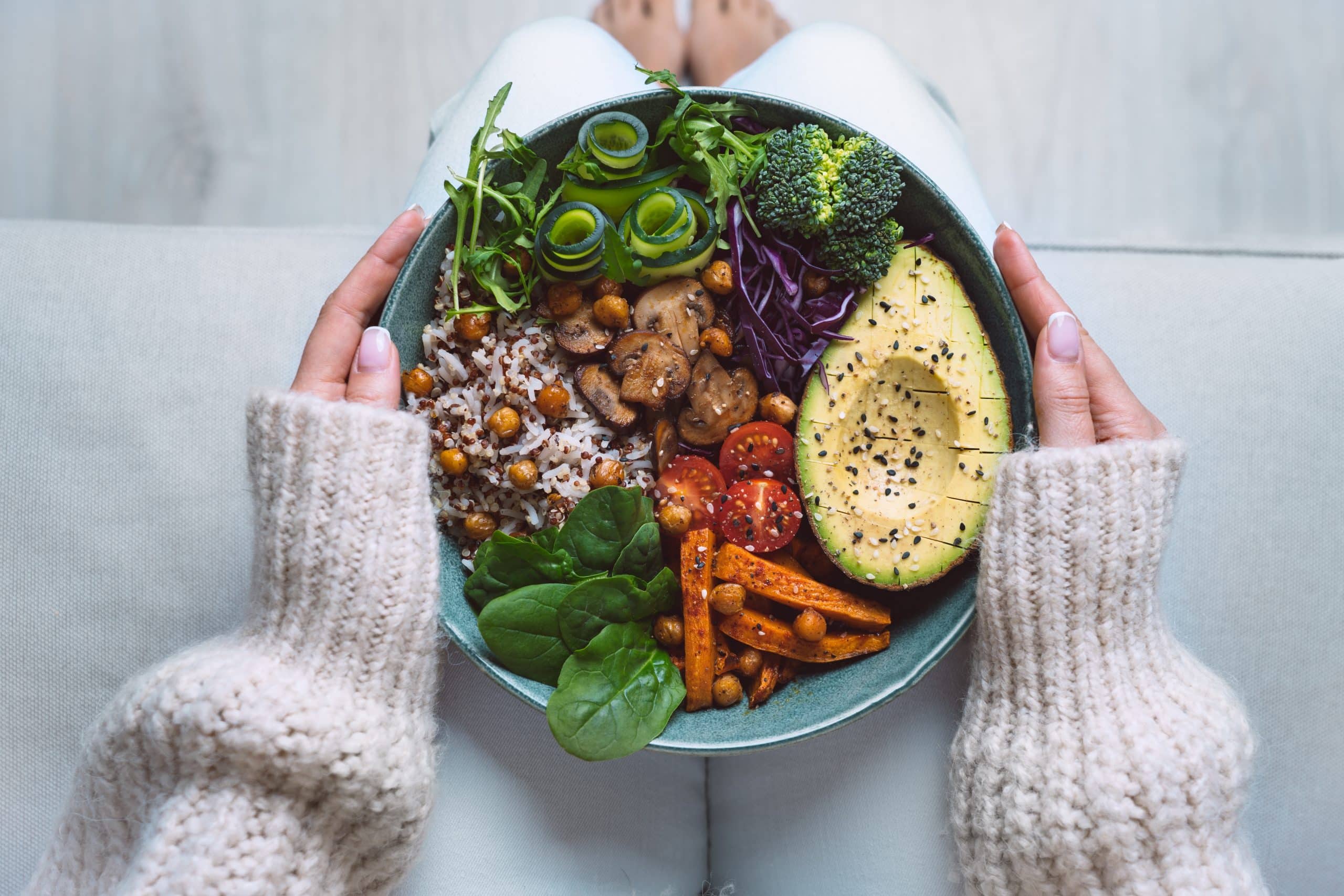It’s no lie that different parts of the world and communities have different standards of beauty and different markers of good health. However, a common theme among many societies is that abdominal fat is not considered desirable. Not only is it seen as a sign of health risks, but most fashions don’t cater to a larger midsection. This leads to insecurity and the desire to lose belly fat in many.
Many people turn to diet in an effort to lose belly fat or to avoid it altogether. But what are the top foods to avoid to lose belly fat? Read on to learn more about the top foods to avoid for a flat stomach, the 10 best foods to eat to lose belly fat, and much more.
How Can I Lose Tummy Fat Fast?
Many online sources love to use the headline ‘how to lose fat overnight (easy trick)’ as a ploy to get you to try fad diets and extreme workout options in the name of quick belly fat loss.
What they fail to tell you is that losing belly fat, or fat on any other part of the body, is not a quick process. It takes time and patience to achieve your desired results, particularly if you have a lot more belly/body fat.
However, this doesn’t mean all hope is lost. Tummy fat loss is highly dependent on your diet and exercise routine. Learning the foods to avoid to lose belly fat is important, as is increasing physical activity. Aerobic exercise is particularly helpful in decreasing visceral fat in the abdomen.
Lean and toned up body isn’t just a far-fetched fantasy. Check out the BetterMe app and watch it propel your weight loss journey into high gear!

Here’s a list of such foods:
Foods to Avoid to Lose Belly Fat
Once again, when it comes to belly fat loss, both diet and exercise matter.
If you want to lose fat in general, including belly fat, you’ll need to burn more calories than you consume. This involves increasing the number of calories you burn by incorporating exercise and simply moving more throughout the day, in addition to decreasing the number of calories you consume. You can achieve this by eating a healthy balanced diet and focusing on nutrient-dense foods from all food groups. These include fruits, vegetables, whole grains, beans and legumes, lean proteins, and healthy fats. Foods that are high in calories but offer little nutritional value can be included occasionally but are best limited.
With that being said, below are 10 foods to limit or avoid to lose belly fat:
Sugar-Sweetened Beverages
A lot of sweet liquids such as pre-packaged juices, sports drinks, soft drinks, and sodas contain a very high amount of added sugar. In addition to the high sugar content, such drinks also generally have a high calorie count and little to no micronutrients, fiber, or protein.
According to the Dietary Guidelines for Americans between 2015 and 2020, it is advised that the volume of your total calories provided by sugary fluids should be reduced. The investigation reported that an average American consumes approximately 17 tsp of sugar daily, which is significantly more than the recommended 12 tsp per day.
Drinks with such a high sugar content and calorie count often make you go over your recommended calorie intake for the day. Eating at a calorie surplus means your body is not able to use up all the energy given to it. The extra calories are stored as fat in the body, which subsequently leads to an increase in weight, belly fat, and overall body fat.
One cross-sectional study review published in the Journal of Nutrition showed that a greater intake of sugar-sweetened beverages is related to body fat and abdominal fat accumulation.
The review findings also stated that those who consume such drinks daily have a 10% higher absolute visceral adipose tissue (VAT) volume and a 15% greater VAT-to-SAT (subcutaneous adipose tissue) ratio compared to non-consumers (29).
Another study published in 2015 mentioned sugar-sweetened beverages as one of the biggest culprits in weight gain in both young children and adolescents (7).
Deep-Fried Foods
When you fry your food, it will most likely contain a high volume of calories, unhealthy fats, and salt. Most restaurants and eating places deep fry their fries to make them crispy. However, the danger in this is that a considerable amount of calories and fat is eventually invested in such food.
French fries are a favorite of many people, but research suggests that they’re not something that should be eaten every day. An 8-year longitudinal study that included 4,440 individuals between the age of 45 and 75 and was published in the American Journal of Clinical Nutrition found that the frequent consumption of fried potatoes (2+ times per week) was associated with an increased risk of mortality (19).
In 2013, a study that included 9,850 men and women was published in the Nutrition, Metabolism and Cardiovascular Diseases journal found that more frequent consumption of fried foods was associated with a higher risk of subsequently developing overweight/obesity (6). Remember, the more weight you carry, the more likely you are to have a bigger belly.
Another study published a year later in The BMJ found the more frequent consumption of fried foods to be associated with increased body mass index (BMI) and obesity, but researchers also advised that a reduction in the consumption of such foods may be important for anyone who is genetically predisposed to obesity (18).
Ultra-Processed Snacks
These include things such as chips, crisps, commercially baked goods, candy, and ice cream. Such snacks are generally rich in empty calories and also high in unhealthy fats, salt and/or added sugar.
In a Brazilian study published in 2015, it was observed that ultra-processed foods were associated with higher values of BMI and obesity in the adolescent and adult populations (9)
More research over the years continues to suggest that the increased consumption of ultra-processed foods, sugary drinks, and snacks likely contributes to greater visceral and overall fat accumulation (10, 8).
White Bread and Pasta
White bread and pasta are delicious. However, when it comes to waist circumference and weight, they should be high on the list of foods to limit to lose belly fat in female and male demographics. Both are made from white flour, which comes from refined wheat flour.
Refined carbs are carbohydrates that have been stripped of all bran, fiber, and other nutrients. Research has suggested that a high intake of refined carbs is associated with increased belly fat and circumference and it may also increase the risk of obesity (28, 21).
If you’re a fan of bread and pasta and cannot imagine going the rest of your life without them, we suggest looking for alternatives made from whole wheat or other flours made from whole grains.

Energy and Granola Bars
This goes back to snacking smart. Not all energy and granola bars are bad for you, but many often have an incredible amount of added sugars to help make them more palatable.
The next time you go shopping, take a minute to read the nutritional info on the packaging of your energy and granola bars of choice. If your favorite comes with a lot of added sugar, switch them out for healthier options.
If your local stores don’t stock healthier versions, or if they’re too expensive, make your own or forgo them altogether. Instead, opt for snacks such as diced apple and peanut butter, berries and plain Greek yogurt, or hard-boiled eggs – they’re high in protein and lower in calories and added sugars.
Read more: Is The Japanese Towel Exercise an Effective Way to Burn Belly Fat?
Alcohol
It’s generally advised that anyone who is hoping to shed some weight around the midsection should avoid alcohol. This is because most alcoholic drinks contain a high number of calories and high sugar content without the essential nutrients that are required for healthy living.
According to The National Institute of Alcohol Abuse and Alcoholism, depending on the type of alcoholic drink you have, you can add anything between 84 and 490 extra calories with just one glass (2).
Not only is alcohol bad for the waistline, it also increases the risk of liver and heart disease, depression, stroke, and stomach bleeding, in addition to cancer of the oral cavity, esophagus, larynx, pharynx, liver, colon, and rectum.
High alcohol consumption can also contribute to problems with the management of conditions such as diabetes, high blood pressure, pain, and sleep disorders. Misusing alcohol may also increase the likelihood of unsafe sexual behavior and the risk of drowning and injuries from violence, falls, motor vehicle crashes, and much more (1).
The CDC advises that adults of legal drinking age who choose to drink should only drink in moderation, which means limiting their intake to 2 drinks or less in a day for men or 1 drink or less in a day for women on days when alcohol is consumed (17).
Processed Meats
While you can’t lose belly fat naturally in a week – this miracle would require you to go under the knife for liposuction – limiting your intake of processed meats can help with the long-term reduction of belly fat.
These processed meats are high in salt, saturated fat, and extra calories.
According to the International Agency for Research Cancer (IARC), meats that have undergone processing of any kind are carcinogenic, meaning that they increase the risk of some types of cancers, particularly colon cancer (20). Examples of processing include salting, curing, fermentation, and smoking.
Processed meats such as hot dogs, ham, salami, jerky, and bacon, to mention a few, should be avoided if you genuinely aim to burn belly fat or are concerned about the risk of cancer. Instead of consuming these, you should opt for unprocessed meats from poultry, lean red meat, and fatty fish.
No matter how much you love consuming any of the categories of diets discussed above, you must make it a point of duty to limit or avoid these foods to lose belly fat.
Can I Reduce Belly Fat in 2 Weeks?
Unless you already have a very low body fat percentage, you cannot lose belly fat in 2 weeks. Sometimes, even reducing belly fat in a month can be difficult. However, it’s not impossible.
By adjusting your diet through limiting or avoiding the foods mentioned above, adding more low-calorie, nutrient-dense foods to the menu, eating on a calorie deficit, and working out, you can reduce it over time.
What Is the Best Food to Eat While Trying to Lose Belly Fat?
Having discussed different food types that can contribute to increased belly fat, here is a list of foods that are ideal for consumption while you’re trying to achieve a whole new belly goal.
Looking for a way to break the vicious cycle of weight loss and tone up all the jiggly parts? Watch the extra pounds fly off and your muscles firm up with the BetterMe app!

10 Best Foods to Eat to Lose Belly Fat
Eggs
Eggs are rich in nutrients (specifically protein and choline) that help in muscle-building and fat-burning. The egg yolk is very rich in choline, which plays a crucial role in burning fats.
A study conducted on the Effect of Choline Supplementation on Rapid Weight Loss and Biochemical Variables Among Female Taekwondo and Judo Athletes found that choline supplementation helped athletes reduce their body mass before competition (13).
Avocados
Avocado is one of the best foods to consume when aiming for a healthy stomach. They are rich in healthy fats and fiber, which can help you feel full for longer and potentially eat less overall. Findings from a trial published in 2021 suggested that consuming just 1 fresh Hass avocado a day may help with the reduction of abdominal adiposity in females (3).
Greek Yogurt
The consumption of this variety of yogurt may help increase the presence of beneficial bacteria in the human gut, which is beneficial for digestion and gut health.
Greek yogurt is also high in protein, which helps build muscle and makes you feel more full for longer, allowing you to eat less overall.
Lentils
These are also some of the most nutritious natural foods that you’ll ever come across, although many people are not aware of this reality. Lentils are filled with essential minerals, vitamins, antioxidants, and plant-based proteins.
The lentil is also very rich in soluble fiber, which helps reduce cholesterol, slows down carbohydrate absorption for more stable blood sugar levels, and supports digestive health.
The results from a 12-week study published earlier this year (2024) showed that increased lentil consumption may help lower cholesterol, in addition to post-meal glycemic responses and inflammation (32).
Nuts
As long as you’re not allergic to nuts, they can make a great addition to a belly fat-reducing and weight-loss diet (25). Nuts are incredibly rich in health-friendly fats and they also contain antioxidants, fibers, plant proteins, and multiple types of essential and non-essential minerals and vitamins.
A 1-ounce portion of nuts such as cashews, hazelnuts, pine nuts, pistachios, pecans, and macadamia nuts makes a healthy snack that can keep you full until your next meal.
Beans/Legumes
Like lentils, beans are also great in helping reduce belly fat and overall weight due to their protein and high fiber content. In one study of 246 women published in 2020, researchers found that the women who consumed moderate or high amounts of beans had less body fat and smaller waists than those with lower intakes (4).
A more recent study review published in Nutrients revealed that legume intake was associated with weight change over 10 years, in addition to being a predictor of BMI and abdominal adiposity, likely due to their fiber content (22).
Fatty Fish
This includes fish such as tuna, anchovies, salmon, herring, mackerel, trout, and sardines. These fish are an excellent source of protein, vitamins, minerals, and omega 3 fatty acids.
Not only are omega 3 fatty acids good for your heart health, research also suggests that supplementing a diet with omega-3 polyunsaturated fatty acids may help with the reduction of abdominal fat mass and percentage in overweight or obese individuals on a weight-loss diet (30).
Lean Animal Protein
Processed meats may be bad for weight management and waist circumference, but lean animal protein has the opposite effects. Protein is the body’s muscle-building block. An increased protein intake (plus exercise) helps you build more muscle – muscle burns more calories than fat, which can help with calorie burning.
In addition, protein helps with increased satiety. Eating less throughout the day helps with calorie restriction, which helps reduce weight and overall belly fat.
Fruits and Vegetables
They are rich in fiber and low in calories. This means that they help with satiety and you can enjoy them without compromising your calorie deficit.
Fruits and vegetables are also rich in vitamins, minerals, and antioxidants, all of which help improve your general health.
Probiotics
These include foods such as yogurt, kefir, sauerkraut, and kimchi. Probiotics are believed to help influence the composition of gut microbiota, improve gut integrity, and restore the microbial shifts characteristic of obesity.
Probiotics may increase good bacteria in the gut, which might work to help reduce body weight and even prevent obesity (26, 27, 16).
If you’re on an intermittent fasting weight loss journey, all the above foods make a great addition to a beginner intermittent fasting meal plan. Remember, while IF doesn’t restrict foods or calories, it’s always best to eat healthy as this makes it more likely that you’ll see results faster and they will be long-term.
Read more: 24 Weight Loss Smoothies, 2 Diet Plans, and 5 Belly Fat Smoothie Secrets
FAQs
What burns the most belly fat?
A combination of a moderate calorie deficit diet plus exercise is what burns the most belly fat and leads to a flatter tummy.
What are the 3 foods to quit for a flat stomach?
For a flatter tummy and smaller waistline make sure you limit or avoid:
- Ultra-processed foods with high added sugar, salt, and saturated fat
- Fried foods
- Refined carbohydrates
What drink burns belly fat?
Plain water and caffeinated drinks such as tea and coffee can help ‘burn’ belly fat.
Research suggests that water acts as an appetite suppressant and also temporarily increases your metabolism, which slightly increases calorie burning, contributing to fat and weight loss, in addition to BMI reduction (15).
Older studies suggested that caffeine consumption can temporarily increase your metabolic rate, which increases calorie burning and fat oxidation. Consuming just 100mg of caffeine may help you burn 79 to 150 kcal more (5, 24).
What should I drink before bed to lose belly fat?
What you drink before bed won’t affect how much belly fat you burn, unless it contributes a lot of calories to your daily intake. You should stick with water or unsweetened herbal tea to maintain your calorie deficit.
What is intermittent fasting bloating?
Intermittent fasting bloating is a possible side effect that comes with changing your diet when doing IF. Please note that the act of fasting may not be what causes the bloating, but the new foods introduced to the diet. If you’re eating more complex carbs, bloating could be a side effect as they’re high in fiber. Talk to your healthcare provider if you have concerns.
The Bottom Line
Taking note of foods to avoid to lose belly fat goes beyond aesthetics. While improved self-esteem and looking good in clothes are good, less belly fat is also good for your overall health. Less belly fat means a reduced risk of obesity, heart disease, and type 2 diabetes. Eat well and exercise, and your body will thank you for it.
DISCLAIMER:
This article is intended for general informational purposes only and does not serve to address individual circumstances. It is not a substitute for professional advice or help and should not be relied on for making any kind of decision-making. Any action taken as a direct or indirect result of the information in this article is entirely at your own risk and is your sole responsibility.
BetterMe, its content staff, and its medical advisors accept no responsibility for inaccuracies, errors, misstatements, inconsistencies, or omissions and specifically disclaim any liability, loss or risk, personal, professional or otherwise, which may be incurred as a consequence, directly or indirectly, of the use and/or application of any content.
You should always seek the advice of your physician or other qualified health provider with any questions you may have regarding a medical condition or your specific situation. Never disregard professional medical advice or delay seeking it because of BetterMe content. If you suspect or think you may have a medical emergency, call your doctor.
SOURCES:
- Alcohol and the Human Body (2024, niaaa.nih.gov)
- Alcohol calorie calculator (n.d., rethinkingdrinking.niaaa.nih.gov)
- Avocado Consumption, Abdominal Adiposity, and Oral Glucose Tolerance Among Persons with Overweight and Obesity (2021, pubmed.ncbi.nlm.nih.gov)
- Bean Consumption Accounts for Differences in Body Fat and Waist Circumference: A Cross-Sectional Study of 246 Women (2020, ncbi.nlm.nih.gov)
- Caffeine and coffee: their influence on metabolic rate and substrate utilization in normal weight and obese individuals (1980, pubmed.ncbi.nlm.nih.gov)
- Consumption of fried foods and weight gain in a Mediterranean cohort: the SUN project (2013, pubmed.ncbi.nlm.nih.gov)
- Consumption Of Specific Foods And Beverages And Excess Weight Gain Among Children And Adolescents (2015, pubmed.ncbi.nlm.nih.gov)
- Consumption of Ultraprocessed Foods and Body Fat Distribution Among U.S. Adults (2023, pubmed.ncbi.nlm.nih.gov)
- Consumption of ultra-processed foods and obesity in Brazilian adolescents and adults (2015, sciencedirect.com)
- Contribution of ultra-processed foods in visceral fat deposition and other adiposity indicators: Prospective analysis nested in the PREDIMED-Plus trial (2021, pubmed.ncbi.nlm.nih.gov)
- corn syrup (n.d., britannica.com)
- Differential effects of fructose versus glucose on brain and appetitive responses to food cues and decisions for food rewards (2015, ncbi.nlm.nih.gov)
- Effect of Choline Supplementation on Rapid Weight Loss and Biochemical Variables Among Female Taekwondo and Judo Athletes (2014, ncbi.nlm.nih.gov)
- Effect of trans fatty acid intake on abdominal and liver fat deposition and blood lipids: a randomized trial in overweight postmenopausal women (2011, ncbi.nlm.nih.gov)
- Effect of ‘Water Induced Thermogenesis’ on Body Weight, Body Mass Index and Body Composition of Overweight Subjects (2013, ncbi.nlm.nih.gov)
- Effects of Probiotics and Synbiotics on Weight Loss in Subjects with Overweight or Obesity: A Systematic Review (2021, ncbi.nlm.nih.gov)
- Frequently Asked Questions (2022, cdc.gov)
- Fried food consumption, genetic risk, and body mass index: gene-diet interaction analysis in three US cohort studies (2014, ncbi.nlm.nih.gov)
- Fried potato consumption is associated with elevated mortality: an 8-y longitudinal cohort study (2017, pubmed.ncbi.nlm.nih.gov)
- IARC monograph evaluate consumption of red meat and processed meat (2015, iarc.fr)
- Intake of macronutrients as predictors of 5-y changes in waist circumference (2006, pubmed.ncbi.nlm.nih.gov)
- Legume Intake, Body Weight, and Abdominal Adiposity: 10-Year Weight Change and Cross-Sectional Results in 15,185 U.S. Adults (2023, ncbi.nlm.nih.gov)
- Losing Belly Fat: A Nutritionist’s Top 5 Foods (2020, health.com)
- Normal caffeine consumption: influence on thermogenesis and daily energy expenditure in lean and postobese human volunteers (1989, pubmed.ncbi.nlm.nih.gov)
- Nuts, Energy Balance and Body Weight (2023, ncbi.nlm.nih.gov)
- Probiotics: How Effective Are They in the Fight against Obesity? (2019, ncbi.nlm.nih.gov)
- Probiotics for the Treatment of Overweight and Obesity in Humans—A Review of Clinical Trials (2020, ncbi.nlm.nih.gov)
- Simple carbohydrates and obesity: Fact, Fiction and Future (2006, nature.com)
- Sugar-Sweetened Beverage Consumption Is Associated with Abdominal Fat Partitioning in Healthy Adults (2014, ncbi.nlm.nih.gov)
- The effect of omega-3 fatty acid supplementation on weight loss and cognitive function in overweight or obese individuals on weight-loss diet (2022, pubmed.ncbi.nlm.nih.gov)
- Trans fats—sources, health risks and alternative approach – A review (2011, ncbi.nlm.nih.gov)
- Twelve Weeks of Daily Lentil Consumption Improves Fasting Cholesterol and Postprandial Glucose and Inflammatory Responses—A Randomized Clinical Trial (2024, mdpi.com)











